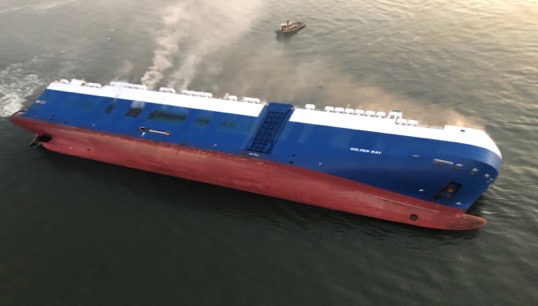- Topics
- Campaigning
- Careers
- Colleges
- Community
- Education and training
- Environment
- Equality
- Federation
- General secretary message
- Government
- Health and safety
- History
- Industrial
- International
- Law
- Members at work
- Nautilus news
- Nautilus partnerships
- Netherlands
- Open days
- Opinion
- Organising
- Podcasts from Nautilus
- Sponsored content
- Switzerland
- Technology
- Ukraine
- United Kingdom
- Welfare
Inadequate training resulted in the loss of the Golden Ray, NTSB investigation concludes
28 September 2021

A US National Transportation Safety Board (NTSB) report found the ship's chief officer had not received sufficient training leading to mistakes onboard. Andrew Linington reports
An officer's failure to correctly carry out stability calculations caused the loss of a 71,718gt car carrier and its US$142m cargo of almost 4,200 vehicles, an investigation has ruled.
The Marshall Islands-flagged Golden Ray heeled to 60 degrees in less than a minute and capsized when water flooded through a pilot door as it made a turn while leaving the port of Brunswick, Georgia, USA, in September 2019.
Investigations revealed that the Hyundai Glovis ship could have capsized on two previous voyages because it had not been carrying sufficient quantities of ballast water – possibly as a consequence of similar errors in stability calculations. On all three voyages the vessel was short of almost 1,500 metric tons of ballast, the investigators found.
Post-accident analyses showed that at the time of the heeling, the metacentric height of Golden Ray was between 0.8m and 1.8m – well below the GM of 2.45m reported by the chief officer.
A US National Transportation Safety Board (NTSB) report has concluded that the chief officer made incorrect entries of ballast tank level data into the shipboard stability calculation computer (LOADCOM), which led to his wrong determination of the vessel’s stability.
Investigators found that the officer had not used the LOADCOM system before, and when he joined the ship about six months before the accident he was given 'a few hours of on-the-job training' by the departing chief officer, which included use of the computer to calculate stability.
The NTSB report points to a ‘lack of proficiency and oversight’ by the ship's operator, South Korea-based G-Marine Service, in failing to ensure that the officer was competent to use the computer and failing to have effective procedures to check the accuracy of stability calculations before departure.
G-Marine Service did not provide training for officers using the ship's LOADCOM program, it noted, and while the safety management system outlined the chief officer's duties – including vessel stability calculations – it gave no instructions on how to use it or to require competency for its use.
The report also highlights the way in which water entered the ship after the capsize, with the open pilot door and open watertight doors leading to flooding which blocked the main exit from the engine room – where four crew members were trapped for almost 40 hours before they were rescued by teams who had to cut holes in the hull.
'The circumstances of this accident show that even when transiting in protected waters, watertight integrity is critical to the safety of the vessel and its crew,' it warns. 'It is essential that the operator ensure that crews verify that all watertight doors are closed in accordance with safety management system procedures.'
The NTSB pointed out that the threat of such an accident had been warned about in 2018, in a US Transportation Research Board report on vessel stability regulations which had stressed 'the potential for risk arising from human error' onboard ships such as car carriers.
The NTSB recommended that G-Marine Service improves its safety management system to establish procedures for verifying stability calculations, and to ensure that checklists on the closure of watertight doors during arrival and departure are adhered to.
Tags
